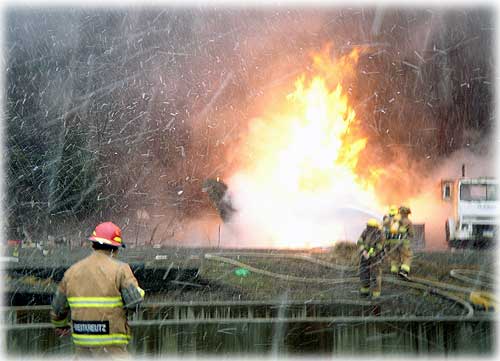 February 04, 2006
 Photograph by Tracy Mettler ©2006
The airline transport certificated pilot Stephen Freeman, the sole occupant, received fatal injuries. Eight persons on the ground received minor injuries. Instrument meteorological conditions prevailed in the area of the accident, according to the preliminary report. The flight departed Visual Flight Rules (VFR) about 1141 from the Sitka Rocky Gutierrez Airport, Sitka, Alaska, and an IFR flight plan was filed. According to Federal Aviation Administration (FAA) personnel, the airplane was issued a special ferry permit by an inspector with the Van Nuys Flight Standards District Office (FSDO), Van Nuys, California, on January 23, 2006, with the options to fly Visual Flight Rules/Instrument Flight Rules (VFR/IFR) day/night from Anchorage, Alaska, to Seattle, Washington. The ferry permit was signed by an FAA certificated mechanic, certifying that the airplane was safe for a ferry flight. According to the operator, the accident airplane departed Palmer, Alaska, on January 23, about 1500, with another L-39MS airplane, with an intended destination of Ketchikan. NTSB stated, due to adverse weather conditions in Ketchikan, the two airplanes diverted to Sitka, and remained there until January 25. The accident airplane pilot obtained two weather briefings on January 25, and departed for Bellingham, Washington, without filing a flight plan. Due to adverse wind conditions along the planned route, the pilot diverted to Ketchikan, and obtained an Instrument Flight Rules (IFR) en route clearance about 12:10 pm. The pilot was cleared for the Instrument Landing System (ILS) approach to runway 11 at Ketchikan, and about 12:48 pm, the pilot reported via radio to the Ketchikan Flight Service Station (FSS) that he had the airfield in-sight, and stated he would attempt to circle to land on runway 29 at Ketchikan, according the to NTSB findings. The preliminary report by the NTSB stated that a pilot-rated witness reported that he saw the airplane descend from the clouds, from about 200 feet above the waters of the Tongass Narrows, near Peninsula Point, which is about 2 miles from the crash site. The witness indicated that the visibility was about 3/4 mile in wet blowing snow, and the wind at the time was from the northwest, about 30 knots. The witness, who was not identified by the NTSB in their preliminary report, indicated he could see the outline of the Alaska Marine Highway vessel "Columbia" as it was southeast bound toward the Ketchikan ferry terminal. The witness said the accident airplane, with the landing gear down, descended on about a 20 to 25 degree angle at a high rate of descent to the surface of the water, about 200 yards from the shore. The airplane struck the surface twice, each time gaining about 10 feet before skipping on the surface for a third time. The first two water impacts produced an extensive spray of water that obscured the witness' view of the airplane. The airplane then gained altitude and climbed out of his line of sight. The preliminary NTSB report noted that several witnesses aboard the vessel "Columbia" reported seeing a large splash in the water between 3/4 to 1 mile in front of the vessel. They thought the splash was a whale, but due the limited visibility of 1/2 to 3/4 mile, none reported seeing or hearing an airplane. The NTSB reported that after the water impact, other witnesses on shore reported seeing the airplane at tree-top level over the town of Ketchikan, and hearing engine sounds, but then the engine stopped making any sound. The pilot was observed to eject from the airplane, but the ejection sequence was incomplete, and he struck the ground while still in his ejection seat. The NTSB stated in its preliminary report, the unoccupied airplane collided with the ground in a large open lot on an easterly heading, struck the western bank of Carlanna Creek, continued over the creek and struck a trailer home that was occupied by two persons, crashed into several unoccupied automobiles, and came to rest in another open lot. Ketchikan Fire Department personnel responded to the scene and evacuated residents, and began fighting the trailer fire and the burning airplane fuselage. While fighting the airplane fire, the rear ejection seat was blown out of the fuselage by the seat's initial ejection charge, landing about 150 feet from the wreckage. The seat's second stage rocket motor did not discharge, and it was rendered safe by military personnel on the evening of January 28th. Portions of airplane wreckage were located in Carlanna Creek, and within the interior of the trailer. The NTSB stated in its preliminary report, further examination of the airplane engine is pending. The Instrument Landing System (ILS) approach to runway 11 has a minimum descent altitude of 1,000 feet mean sea level (msl), with the missed approach point at 2.7 miles from the runway touchdown point. The water impact location is about 1.2 mile from the runway threshold, and about .4 mile left of the runway centerline. Runway 11 at Ketchikan is 7,500 feet long. At 12:53 pm, an aviation routine weather report (METAR) at Ketchikan was reporting, in part: Wind, 330 degrees (true) at 14 knots; visibility, 4 statute miles in light snow and mist; clouds and sky condition, 400 feet scattered, 1,200 feet broken, 2,300 feet overcast; temperature, 36 degrees F; dew point, 34 degrees F; altimeter, 29.33 inHg; remarks, harbor wind, 310 degrees (true) at 11 knots, gusts to 18 knots. A special weather observation at 1:04 pm was reporting, in part: Wind, 330 degrees (true) at 14 knots; visibility, 2 statute miles in light snow and mist; clouds and sky condition, 400 feet scattered, 1,000 feet broken, 1,800 feet overcast; temperature, 34 degrees F; dew point, 34 degrees F; altimeter, 29.33 inHg. The official final report has not been completed by the National Transportation Safety Board and this preliminary report is subject to change. The NTSB investigator-In-Charge is Scott Erickson.
Full Report:
Publish A Letter on SitNews Read Letters/Opinions
|